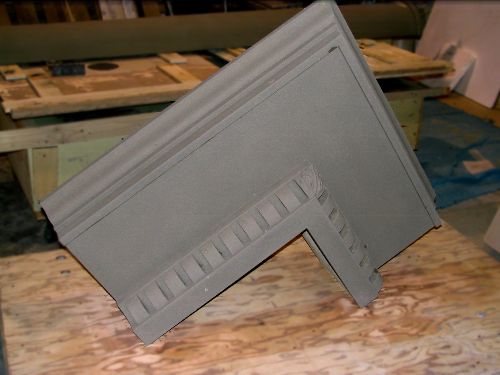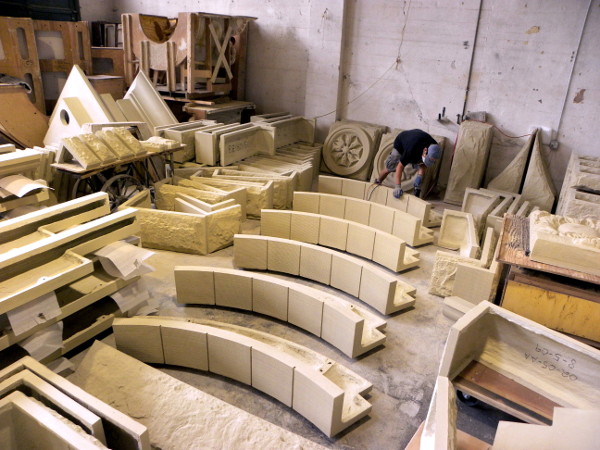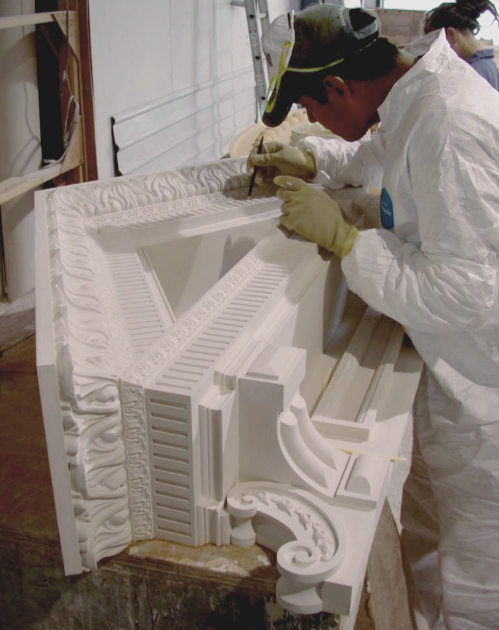With over 35 years of experience, Architectural Castings has the know-how to assist in the selection of materials and processes that will provide the best value and long-lasting durability over time. We are particularly adept at developing models and molds that provide the best combination of economy and performance for the requirements of each project. So, how does one select the proper material for a job? Here are some key considerations:
- The material and its physical properties – Does it lend itself to the shapes we need to create, how strong is it, is it dimensionally stable, can it be integrally pigmented or can it accept (or does it require) a paint finish?
- Usage/location – Is it interior or exterior, is there freeze/thaw exposure, is it subject to high traffic or abuse, how long does its life expectancy need to be, what are its visual needs?
- Project conditions – How might our product interact with adjacent materials, is panelization possible or is it a situation where individual blocks might better suit the conditions or the skills of the job-site trades. The availability of qualified or knowledgeable installation labor often enters into this assessment.
- Cost – For the parts delivered to job-site, for their installation and finishing and the likely costs of long-term maintenance.
There are almost always trade-offs and compromises; often, the best choice is a combination of materials and/or techniques. Any of these materials can succeed as long term solutions if they are carefully conceived, executed, and maintained, but any of these materials can fail with astonishing speed if they are poorly produced and/or installed.

A short list of our materials includes the current industry standards:
- Glassfiber Reinforced Concrete (GFRC)
- Pre-cast concrete and Cast stone
- Polymer-modified Glassfiber Reinforced Gypsum (PGRG)
- Fiberglass Reinforced Plastic (FRP)
- Glassfiber Reinforced Gypsum (GRG)
But we aren’t limited to this list. When the project calls for it, we’ve used cast, sheet and extruded metals, and even stucco and painted wood, which can sometimes be the simplest and most cost-effective materials to use.
Glass Fiber Reinforced Concrete (GFRC)
A composite of Portland cement, fine aggregates and typically a minnow (5%) polymer admix that is reinforced with alkali resistant glass fibers
- This is the heaviest of thin-shelled products although still a fraction of conventional pre-cast concrete
- Comparatively low strength, especially in flexure, and physical properties decline substantially when saturated
- Often utilizes applied sealers to reduce moisture absorption
- Except for small parts, GFRC usually requires a flexibly mounted, light gauge metal sub-frame for installation
- Pigmented, aggregated facing mixes can replicate natural stone or conventional concrete appearance. Can be paint finished with breathable coatings
- Noncombustible formulations, without polymer admixes, can provide rated fire-resistive enclosures, although removing the polymer reduces ultimate part durability
- Slight surface texture of material makes it difficult to finish joints to a smooth, seamless degree if required
- GFRC carries medium/high production costs and medium installation costs
Top Right: GFRC parts created for the Furuya Building
Bottom Right: GFRC parts in process


Precast Concrete and Cast Stone
Materials range from conventional wet-mix concrete that is poured and vibrated, to dry-pack cast stone that uses very low water content, fine aggregate mixes that are tamped into molds.

- The heavy weight often impacts cost of production and shipping as well as surrounding construction and installation
- Often load-bearing, although it's own weight may be too great to bear on adjacent materials i.e., terra cotta
- Long history of use and installation by masonry trades, although seismic restraint issues have changed methods and detailing
- Unlike most thin-shell materials (especially those with high polymer content), it has a low thermal expansion coefficient
- Commonly uses integral aggregates and pigments to replicate natural stone or can be finished with breathable paint coatings
- Dimensional issues become more important because parts are not as easily field cut as thin shell materials
- Production cost is low/medium and installation cost is medium/high
Left: The reconstruction of a cast stone part to make a mold from.
Polymer-modified Glass Fiber Reinforced Gypsum (PGRG)
A gypsum and glass fiber composite developed for exterior use that replaces the normal mix water with an acrylic polymer system, which comprises approximately 40% of the matrix.
- Newest of thin shelled composites; least history of installation
- Moderate weight with very good dimensional stability and sufficient strength do not require supporting sub-framing as with GFRC
- Water-based acrylic resin binder yields low flammability and low toxicity material to fabricate
- Subject to surface erosion after extended freeze-thaw exposure, although the problem is eliminated with breathable paint coatings
- Rapid de-molding time can minimize molds required to achieve project schedules
- Can be pigmented and/or aggregated to match stone and works well with integral metallic powders for interiors
- Avoid use where parts can become saturated from inherent water traps or standing on grade with pooling potential
- Smooth surface parts can be field-assembled and finished into a monolithic whole
- Carries Low/medium production costs and medium installation costs

Fiberglass Reinforced Plastic (FRP)
The original thin-shelled composite that combines various forms of glass fiber reinforcement with polyester or, occasionally, epoxy resins
- Potentially the lightest and strongest of thin-sell exterior materials with the greatest length of field history
- Sufficient strength to install without sub-framing, even in larger shapes
- Very low absorption yields very good freeze-thaw performance and suitability for potentially saturated conditions
- Dimensional stability and warpage can be a problem especially with flame-retardant fillers and/or aggregated surface coats
- Highly combustible without flame retardant additives
- Provided with a molded-in gel coat color, or can be painted with a variety of paint systems without concern for breathability
- Medium production and installation costs
Glass Fiber Reinforced Gypsum (GRG)
This is a combination of high strength gypsum plaster with glass fiber materials that yield lighter, stronger, and often much larger elements than traditional fibrous plaster moldings.
- GRG produced parts are very light but stiff
- This material is optimal for interior applications
- It is noncombustible
- Parts can be easily field-cut and mechanically fastened to minimal framing and finished with conventional drywall materials
- Economic alternative to swept plaster or assemblies of multiple pieces of wood
- Consistent, quantifiable physical properties lend the product to use in engineered situations such as severe seismic zones
- GRG accepts a wide range of applied coatings or can utilize integral aggregates and pigments to simulate natural stone
- Relatively low production and installation costs

We look forward to hearing about your project.
Contact us and let's get into the nuts and bolts!
